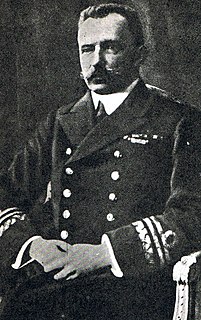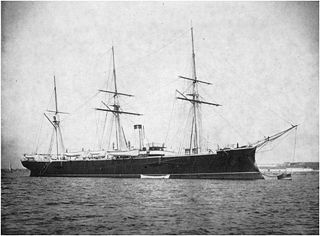Six ships of the Royal Navy have borne the name HMS Cossack, after the Cossack people of Eastern Europe, whilst another was begun but was cancelled while building:

Kazimierz Porębski was a Polish career naval officer who rose to the position of admiral within the Imperial Russian Navy, and was subsequently the first commander-in-chief of the inter-war Polish Navy.

The Memory of Azov is a jewelled Easter egg made under the supervision of the Russian jeweller Peter Carl Fabergé in 1891 for Tsar Alexander III of Russia. It was presented by Alexander III as an Easter gift to his wife, the Tsarina Maria Feodorovna. It is currently held in the Kremlin Armoury Museum in Moscow.

Rurik was an armoured cruiser built for the Imperial Russian Navy in the early 1890s. She was named in honour of Rurik, the semi-legendary founder of ancient Russia. She was sunk at the Battle of Ulsan in the Russo-Japanese War of 1904–05.

Imperatritsa Ekaterina Velikaya was the second of three Imperatritsa Mariya-class dreadnoughts built for the Imperial Russian Navy during World War I. Completed in 1915, she was assigned to the Black Sea Fleet. She engaged the ex-German battlecruiser Yavûz Sultân Selîm once, but only inflicted splinter damage while taking no damage herself. The ship briefly encountered an Ottoman light cruiser, but mostly covered the actions of smaller ships during the war without firing her guns. These included minelaying operations off the Bosporus and anti-shipping sweeps of the coast of Anatolia. Imperatritsa Ekaterina Velikaya was renamed Svobodnaya Rossiya after the February Revolution of 1917.

The Bogatyr class were a group of protected cruisers built for the Imperial Russian Navy. Unusually for the Russian navy, two ships of the class were built for the Baltic Fleet and two ships for the Black Sea Fleet.
A bogatyr is a folk or epic hero in Russian culture.

The British campaign in the Baltic 1918–1919 was a part of the Allied intervention in the Russian Civil War. The codename of the Royal Navy campaign was Operation Red Trek. The intervention played a key role in enabling the establishment of the independent states of Estonia and Latvia but failed to secure the control of Petrograd by White Russian forces, which was one of the main goals of the campaign.

Pamiat Azova was a unique armoured cruiser built for the Imperial Russian Navy in the late 1880s. She was decommissioned from front line service in 1909, converted into a depot ship and sunk by British torpedo boats during the Baltic Naval War, part of the Russian Civil War.

Oskar Wilhelm Enqvist was a Finland-Swedish admiral in the Imperial Russian Navy, noted for his role in the Russo-Japanese War of 1904-1905.

Komintern was a Soviet light cruiser originally named Pamiat' Merkuria, a Bogatyr-class protected cruiser built for the Imperial Russian Navy. She saw service during World War I in the Black Sea and survived the Russian Civil War, although heavily damaged. She was repaired by the Soviet Navy and put into service as a training ship. In 1941 she was reclassified as a minelayer and provided naval gunfire support and transported troops during the sieges of Odessa, Sevastopol, and the Kerch–Feodosiya operation in the winter of 1941–1942. She was damaged beyond repair at Poti by a German air attack on 16 July 1942. Afterwards she was disarmed and hulked. At some point she was towed to the mouth of the Khobi river and sunk there as a breakwater on 10 October 1942.

Pamiat' Merkuria was an unarmored cruiser of the Imperial Russian Navy. She was initially named Yaroslavl, but was renamed on 9 April 1883.
At least three warships of Japan have borne the name Tone:
Heibetnuma was an unprotected cruiser with a composite hull of the Ottoman Navy, laid down in 1881 at the Constantinople dockyard and completed in 1893. The ship had six rectangular boilers and carried about 280 tons of coal. The main armament was three Krupp 6.7in/25 caliber 5.6 ton breechloading guns, mounted fore and aft. The secondary guns were six Krupp 4.7in/25 BL guns in sponsons amidships.

Navy of the Ukrainian People's Republic was a marine military force of the Ukrainian People's Republic that was based on a free will of Imperial Russia sailors to pledge allegiance to Ukraine. The force was never fully operational as the country constantly fought for its survival with the neighboring Soviet Russia. Eventually most of the Black Fleet was either sunk by the Bolsheviks or become part of expeditionary force of the White movement on evacuation.
The action of 10 May 1915 was a naval encounter between the Russian pre-dreadnought squadron and the Ottoman battlecruiser Yavuz Sultan Selim in the Black Sea. After a brief exchange of fire the Ottomans withdrew.
Pyotr Pavlovich Kitkin was a Russian military commander in the First and Second World Wars, being promoted twice to Rear Admiral, once by the Imperial Russian Navy on 28 July 1917, and once by the Soviet Navy, on 5 November 1944.
This page is based on this
Wikipedia article Text is available under the
CC BY-SA 4.0 license; additional terms may apply.
Images, videos and audio are available under their respective licenses.










